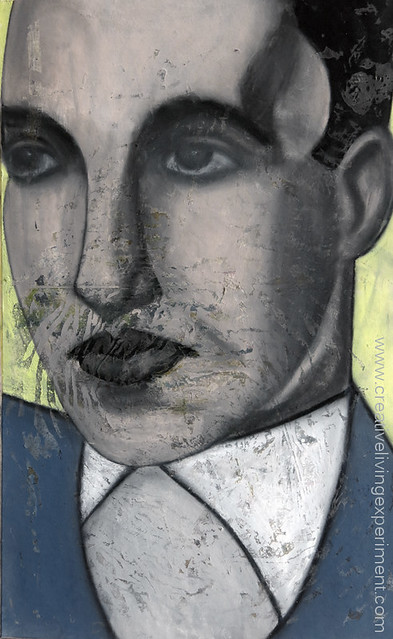Buster (based on a piece by Tamara de Lempicka)
16"h x 10"w, acrylics, charcoal and pastels on mat board
he was completed over five studio sessions
***
These past few weeks I gave myself a
goal: go to the art table first thing in the morning before heading out to the office. That's four days a week, first thing, 6:15am, for 30-40 minutes.
I did it. And I showed up on non-office
days too.
Fourteen days in a row I showed up at
the art table and made art, and in those two short weeks I finished
three pieces. THREE pieces! That's more than I've ever finished in
such a short amount of time without class assignments to nudge me along.
What pushed me to experiment with this
is fodder for another post, but the key thing to take away here is
that, based on what I've experienced this month so far, it's true
what Ms Kane says below:
“Consistency builds confidence.”
~
Christine Kane
I knew it, I guess I just needed the
reminder.
When I'm in the studio every day I
learn, I practice and I get better. I gain a sense of completion.
Consistency brings forward movement, it creates momentum.
This past weekend I chose to take a
break for two days, but today I will be back at it even if it's only
for 15 minutes. And tomorrow morning, when the alarm rings, I will
mosey on to the art table and create once more.
***
If you've been thinking of implementing a
regular creative practice, try starting small. Treat it as an experiment.
Here
are five tips to get you started:
1. Set a finite goal. Don't go in with the
pressure of making art every day forever, set a goal with a finite
amount of time and evaluate when you're done. Set
yourself up for success: five or seven days in a row is a good, doable target. Then, one day at a time, meet that. When you're
done set a new goal.
2. Experiment with your schedule. On
office days I go to the studio first thing in the morning because it
starts the day on a positive and satisfying note; on days at home I'm
more flexible. Experiment with
the best time of day for you to focus on creating and with the
length of your sessions. Notice what works and what doesn't. Shift where you need to.
3. Prepare things ahead of time. If you're
like me and moonlighting at an outside job (ahem), do what you can ahead of time. Pre-prep your painting
surfaces, download your photos from your camera, brainstorm your
writing topics for the week... That way on office days, when time is
at a premium, you'll be able to make the most of your creative time.
Prep work is also great for those days when your creative mojo may be
on the low side; it's forward movement that doesn't necessarily
demand too much energy.
4. Practice self-compassion. Don't beat
yourself up if you miss a day, life happens. Just go back to it the
next day. If you're skipping a lot of days try shifting your time of
practice, or the length of time you spend creating. What practices
could you undertake that would move you forward without taking up too
much time? A daily 10-minute sketch is more than a daily no-minute
sketch, and the confidence you'll gain by doing it is worth gold.
5. Reap the rewards. What have you learned
during your experiment? About your craft? About your process? What
small – or big – successes came about? Acknowledge and celebrate
forward movement.
***
Are you up to the challenge?
I hope so.
The world needs your creative gifts.
Now go,
create.


